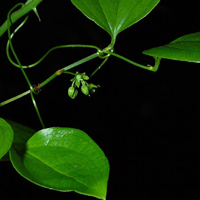Round-leaved Greenbrier
Scientific name: Smilax rotundifolia

Cover photo credit: Allen Woodliffe
Status
Threatened
“Threatened” means the species lives in the wild in Ontario, is not endangered, but is likely to become endangered if steps are not taken to address factors threatening it.
Date added to the Species at Risk in Ontario List
The Round-leaved Greenbrier was already assessed as threatened when the Endangered Species Act took effect in 2008.
What it looks like
Round-leaved Greenbrier is a woody, climbing vine that can grow to over six metres in length as it wraps around shrubs and trees. The main stems are rounded and have flattened prickles. The leaves are egg-shaped and about five to 10 centimetres long.
The plant produces clusters of small, green flowers that bloom from late May to mid-June. The fruit, which ripens in the fall, is bluish-black in colour and usually contains two seeds.
Where it lives
In Ontario, Round-leaved Greenbrier is found mainly in the warmer climate of the Carolinian Forest. It prefers open moist to wet woodlands, often growing on sandy soil.
Where it’s been found in Ontario
The species is found across much of eastern North America from southwestern Nova Scotia to northern Florida, eastern Texas and north to eastern Michigan and southwestern Ontario. As of 2007, thirteen populations were known in Ontario.
What threatens it
The greatest threat to the Round-leaved Greenbrier is habitat degradation and destruction.
Ontario populations of Round-leaved Greenbrier persist in habitat fragments and only a few of these populations can reproduce sexually since many appear to consist of all male or all female plants.
Action we are taking
Threatened species and their general habitat are automatically protected.
Recovery strategy
A recovery strategy advises the ministry on ways to ensure healthy numbers of the species return to Ontario.
Read the executive summary and the full document (December 7, 2018).
Government response statement
A government response statement outlines the actions the government intends to take or support to help recover the species.
Read the government response statement (September 5, 2019).
Review of progress
A review of progress made toward protecting and recovering a species is required no later than the time specified in the species’ government response statement, or not later than five years after the government response statement is published if no time is specified.
Read the report on progress towards the protection and recovery of 12 species at risk, including Round-leaved Greenbrier (2024).
Habitat protection
General Habitat Protection - June 30, 2013
What you can do
Report a sighting
Report a sighting of an endangered animal or plant to the Natural Heritage Information Centre. Photographs with specific locations or mapping coordinates are always helpful.
Volunteer
Volunteer with your local nature club or provincial park to participate in surveys or stewardship work focused on species at risk.
Be a good steward
- Private land owners have a very important role to play in species recovery; if you find Round-leaved Greenbrier on your land, you may be eligible for stewardship programs that support the protection and recovery of species at risk and their habitats
- Invasive species seriously threaten many of Ontario’s species at risk; to learn what you can do to help reduce the threat of invasive species, visit:
- Pollinators, such as bees, are in steep decline across the globe and they play a key role in the survival of many of Ontario’s rare plants; for information on how you can help scientists monitor pollinator populations in Ontario, visit: Seeds of Diversity.
Report illegal activity
Report any illegal activity related to species at risk to
Quick facts
- The seeds of Round-leaved Greenbrier can remain buried in the soil for at least three years while waiting for the right conditions to start growing a new plant
- The young seedlings of Round-leaved Greenbrier are a popular food for white-tailed deer, which can be a problem for this rare plant in areas with large deer populations